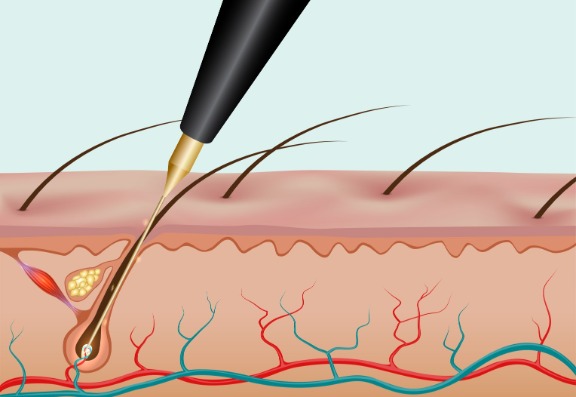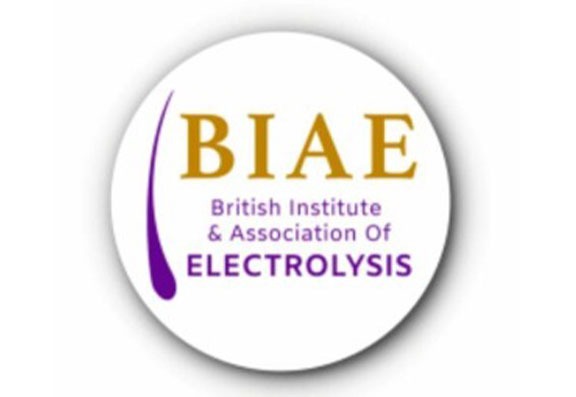Having first been used for permanent hair removal way back in 1875, Electrolysis is still going strong and is perhaps the beauty industry’s best-kept secret.
Over the years its effectiveness has been tried, tested, and proven time and time again with documented clinical trials; and yet still, the myths around what it is and how it works remain.
Here the British Institute & Association of Electrolysis (BIAE) dispel the myths and lay out the truth…
Firstly, let’s clear up what Electrolysis actually is.
Electrolysis is the insertion of a very fine, sterile probe (the same diameter as a hair) into the hair follicle, which is a natural opening in the skin.
The probe is not a needle and is not felt going into the follicle, as it does not pierce the skin at all. When the probe is in place, a tiny amount of energy is discharged along with it.
This energy destroys the hair follicle either by heat, a chemical reaction, or a blend of the two; depending on the method used.
The only sensation felt by the client is heat passing down the probe. Once the follicle is destroyed, the hair growth is permanently eradicated and cannot return.

Fact: It’s well known that pain tolerance is subjective. We’ve all heard conversations about childbirth between women, and for every one person that claims it was akin to torture, another will claim they meditated their way through, drug free, and barely felt a thing. Fortunately, whatever camp you fall in to, Electrolysis can be adapted to suit all.
The state of the art technology in today’s machines means that no one need be suffering during treatment. At worst, some claim to feel a mild stinging sensation (this can be combatted with topical local anaesthetic), and at best it’s virtually pain free.

Fact: Electrolysis treats each and every hair follicle, totally eradicating hair growth long term. So depending on the area, hair type and the density of hair growth, the time taken to achieve permanent hair removal can vary. Some may require between 9 to 18 months treatment, others may need less.
There’s no denying it’s a longer process than quickly running the razor over your legs every day, but in the scheme of life it’s a very short term commitment for an incredible long term gain. Potentially, 1 year of regular Electrolysis appointments could mean you’ll never have to worry about unwanted hair again for the rest of your life.
Fact: Electrolysis is suitable for both large and small areas. No hair growth is too extensive or too strong for electrolysis to be successful – anything from a few fine hairs in any area to a full beard or full legs can be treated successfully.
Additionally, there is no restriction on which areas of the body Electrolysis can be performed on.
Everywhere from the anus to the eyelashes (yes, really!) can be treated successfully.
Fact: Not as expensive as you might think. Let’s compare the price of a bikini waxing session with the price of a short Electrolysis session.
A bikini wax costs approximately £15 upwards, depending on what style of wax you have and the area of the country you live in. A short session of Electrolysis costs between £15 to £20.
Now let’s look at how long you’ll need treatment for.
For Electrolysis, expect to need a course of regular treatment over a period of months, which, once completed, will eradicate your hair growth permanently. No maintenance required.
For waxing, you’ll need to return to the salon at least every 4 - 6 weeks for the rest of your life. Assuming a woman started visiting a salon at age 20, returning every 4 – 6 weeks for appointments, at 60 years old how much will she have spent on waxing over the last 40 years? This makes electrolysis by far the cheaper option long term.
Fact: Electrolysis is needed now more than ever. This is because, contrary to popular belief, Laser and IPL treatments cannot achieve completely permanent removal of all hair.
Due to their current popularity, there is a wealth of misinformation in the public sphere about both Laser and IPL treatments, and many people expecting permanent results from these will find that eventually, their hair growth returns in some way.

It is then that Electrolysis is needed to eradicate the remaining hair growth permanently.
Whilst laser and IPL treatments can no doubt achieve long term hair reduction, the fact is that Electrolysis is the only clinically proven method to destroy the hair follicle completely, making it impossible for the hair to return once the course of treatment has been completed, and therefore the only permanent method of hair removal.
Fact: There is no risk of scarring or any type of permanent marking if the treatment is carried out correctly by an experienced and qualified practitioner.
However, as with any treatment in the beauty industry, it is extremely important that consumers are cautioned against scam treatments that are wrongly promoted as Electrolysis, and warned about the possibility of bad Electrolysis being carried out by unskilled practitioners.
In the UK, licensing arrangements for Electrolysis vary from town to town, and training standards differ from college to college, so consumers need reliable guidance on how to select an Electrolysis that they can trust.
If you want to read more, the experts at Consulting Room really know what they're talking about and have put together Electrolysis, hair removal, scarring and advanced cosmetic procedures FAQs just for you.
If you have more questions, you can use the Electrolysis, hair removal, scarring and advanced cosmetic procedures questions feature to talk to our panel of trained medical experts.
If you're keen to get started with any of these treatments right away then you're in luck - those clever folks also have a list of trusted, accredited Electrolysis, hair removal, scarring and advanced cosmetic procedures in your area.
This blog was written by The British Institute and Association of Electrolysis (BIAE) which are a non-profit organisation that was set up to promote the safe and effective use of electrolysis across the UK, with their entire focus on the interests of the UK consumer.
The BIAE is the only professional body that requires its members to pass strict entrance examinations, and undergo rigorous checks on an ongoing basis.
This ensures its members are trained and educated to a higher standard than anybody else performing the treatment in the UK.

Hey, wait!
Before you go.....
Let's stay in touch, pop your details here and we'll send our editor's hand-picked updates on your fave subjects.